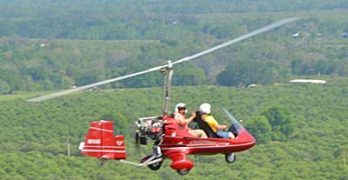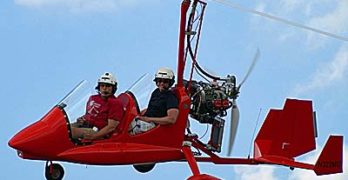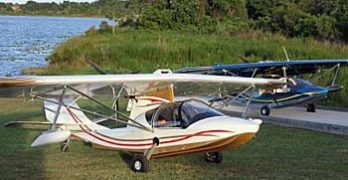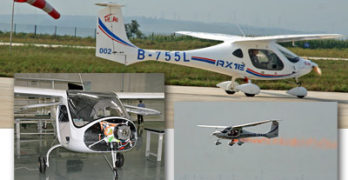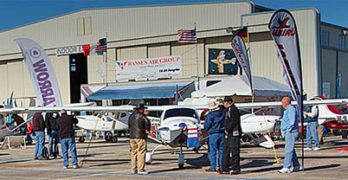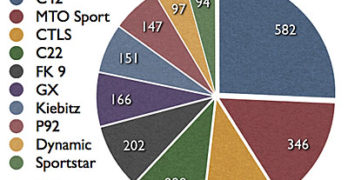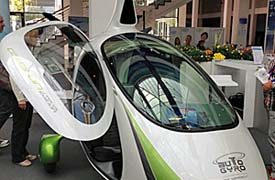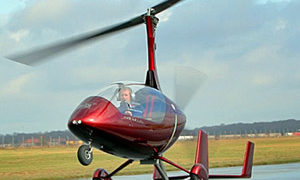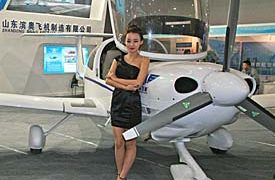Welcome to a guest editorial by Roy Beisswenger, publisher of Powered Sport Flying magazine and a close follower of the gyroplane scene. —DJ
Bensen Days in Wauchula, Florida is our annual pre-game party leading up to Sun ‘n Fun. The Sunstate Wing & Rotorcraft Club schedules this annual soiree to coincide with Sun ‘n Fun. By holding their fly-in one week before SnF, they make it possible for vendors and participants to get a two-for-one deal. One trip south gets them two great sport aviation events. The scheduling certainly makes it possible for Vickie and me to participate.
Gyroplane organizations are not the huge organizations that we see sponsoring major events like Sun ‘n Fun and AirVenture. There is no paid staff and no big budget. The volunteers that put it together collect fees and donations to cover their expenses and build up the kitty for the next event.
Search Results for : AutoGyro
Not finding exactly what you expected? Try our advanced search option.
Select a manufacturer to go straight to all our content about that manufacturer.
Select an aircraft model to go straight to all our content about that model.
Transcontinental Gyroplane Record Underway Now
As I write this, an intrepid gyro pilot is “out on the course” as we used to say when I flew in hang gliding competitions. By the time you read this, he may be all the way home. What a great effort! I hope Paul earns a world record but either way, I feel certain he enjoyed the experience.
“Paul Salmon is currently crossing the country in a record attempt in a Magni M22,” said Greg Gremminger, importer for the Italian Magni Gyro line of aircraft. “He is trying to set the record for a gyroplane to cross the country in both directions.”
Greg added that Paul is on pace to set the record time, back and forth, in just four days. “This attempt is in the 500 kilogram + (1,100 pound) gyroplane category,” added Greg. “There are no records established for this category. The under 500 kilogram category gyro record is currently about 14 days.
The World of LSA and American Opportunities
Updated 8/21/15 — This article has been updated with a reader comment seen at the bottom.
When the SP/LSA regulation was announced 11 years ago nearly all registered Light-Sport Aircraft originated in Europe. Indeed, the first two accepted as SLSA were the Evektor SportStar and Flight Design’s CT series. For several early years, Europe accounted for more than two-thirds of all LSA brands in the USA.
However, in a decade, a lot has changed.
Now, American companies have had time to shift from kit making (a very different business model) or have developed brand-new aircraft or offer a revised version of an existing model to meet the ASTM standards so they could gain FAA acceptance.
American companies are also starting to make inroads into other countries that accept ASTM standards.
Some countries simply copy FAA regs while others accept the ASTM standards set and then layer on some of their own regulations.
Day Two: LAMA Award and New Rotax Engine
Here is more news from AirVenture 2015, coming from Tuesday, Day Two.
The Light Aircraft Manufacturers Association gave a press conference to a full house. LAMA enjoyed a terrific opening day in its mission of advocacy for Light-Sport, light kit, and ultralight aircraft. Partnered with the U.S. Ultralight Association (USUA), LAMA participated in two very productive meetings, one with EAA’s advocacy experts and another with several key FAA personnel. USUA’s Roy Beisswenger and I hope for good things to follow but felt highly energized that we moved closer to some goals we believe can truly help the light aircraft industry and its pilots.
That was the “business” portion of LAMA’s press conference, but we kept it brief as we had a more meaningful message to deliver.
LAMA has presented its President’s Award for 24 years running to an outstanding individual whose work benefitted the light aircraft sector. Announcing this year’s recipient was one of those bittersweet moments.
eAirplanes at Aero 2015 Plus Major Motor News
With Aero mere days away now, excitement is growing for the electric aircraft event-within-the-event. Visitors can tour around the entry foyer hall where the e-flight-expo will be located. This year offers a few highlights, provided to me from my publisher friend Willi Tacke in Germany.
One aircraft not many Europeans and even fewer Americans have seen is the Chinese RX1E made by the Liaoning Ruixiang General Aircraft Manufacturing Company. An electric motorglider, RX1E earned its CAAC Type Design Approval (TDA) earlier this year using ASTM standards (article). Willi reported, “The Chinese team lead by chief developer Professor Dr. Yang Fengtian is now seeking certification in other countries such as Germany or France.
Some companies will not be attending not because their projects have stopped but because they are at critical junctions. Among those missing will be the Volocopter from e-Volo nor any man-carrying aircraft display by Yuneec — which last year showed their eSpyder that had just won German approval.
Four Days of Sebring 2015
Sebring is history, which says the aviation year is now underway. On whole it was a good show and a solid start to 2015. Sebring’s weather was overcast and cool to start though even that didn’t seem to dampen buying enthusiasm. About a dozen airplanes were sold plus numerous vendors reported finding many good prospects. By Friday afternoon the skies went to deep blue and the Sunshine State earned its nickname.
“It was a great Saturday,” wrote U.S. Sport Aviation Expo organizers. The 11th annual Expo nearly filled the auto parking lot and the transient aircraft parking area was hopping with activity, officials said.
While I write about the good news of Sebring, I want to pay respect to two fallen aviators. Dennis Day and Jason Spinks of the Aero Adventures company lost their lives in an unfortunate accident during the event. I offer my sincerest regret for this loss to their families and to the DeLand Airport business team.
Germany’s Top 10 Ultralights by Aerokurier
Much of what we hear and know about airplane populations is centered on America. Yet in the world of sport and recreational aviation, the rest of the world equates to at least a 1:1 relationship, that is, for every American aircraft flying, many experts agree another flies internationally. It may be more significant than that … consider Germany.
In mid-August, our friends at Aerokurier, Germany’s leading aviation magazine, assembled an article about the top 10 ultralights in that country. A European ultralight, as you may know, is not the same as an American ultralight that is today limited to a single seat and no more than 254 pounds of empty weight. In Germany and elsewhere around the European Union, “ultralight” refers to an airplane much like a U.S. Light-Sport but limited in weight to 472.5 kilograms or 1,041 pounds.
Originally the weight limit had been 450 kilograms or 992 pounds but because emergency airframe parachutes are mandatory in Germany the weight was increased a few years ago to cover this component.
Aero 2014 Review … Starting to Think AirVenture
Life has settled down a little after the rush that began at the end of March. Five weeks back, Sun ‘n Fun was approaching to kick off the season of recreational flying.
Aero in Germany followed with only a one day break before boarding the airliner to Europe followed by plenty of follow-up and contemplating the hot and fast action. With a couple weeks of perspective and to answer a common question — How does the industry look in Europe? — I have some final observations.
I found five areas to consider and list them below. Among all the many wonderful aircraft I saw, two particular subgroups stood out for me personally, one for its sheer success and the other for its subtle return to a higher interest plateau.
I refer first to gyroplanes and secondly to, well … what to call them? How about simply “ultralights?” Even that word isn’t right because Ultralight in Europe means something quite different from ultralight (vehicle) in the USA.
The Other LSA Revolution (Except Not SLSA)
Wings that go around in circles enjoy their own special niche in American Light-Sport aviation. Yankees can buy ultralight helicopters — including the Mosquito that can fit into Part 103, which is amazing in itself — and Americans can buy kit-built gyrocopters or gyroplanes (the terms are used interchangeably). The good news is Americans do indeed buy and build; AutoGyro USA sold some 30 examples in the last couple years. However, due to an apparent (and somewhat mysterious) intraagency dispute, fully built Special LSA gyroplanes were never allowed by FAA. Some say it was a turf war between the Small Aircraft Directorate and the Rotorcraft Directorate; though others disagree this was the problem. Whatever the explanation, no ready-to-fly LSA gyros are available in the USA despite years of effort by ASTM committee members, which has a standard ready. This is a shame as I rediscovered for myself on a flight at Sebring.
LAMA (Europe) Investigates the China LSA Market
My LAMA Europe counterpart and friend, Jan Fridrich, took another trip to China in October as he attended Xi’an, said to be the largest General Aviation exhibition in the country. While the show was large with expansive, expensive exhibit stands, airplanes were sparser than events such as Aero Friedrichshafen. Like a few American events (thinking of AOPA’s just concluded Summit and NBAA’s giant show), Xi’an’s convention hall housed indoor displays while the “static” display of more airplanes was at an airport. U.S. organizers usually try to colocate these two displays. In contrast, Jan reported, “The static exhibition was at the airport in Pucheng, which is about 100 kilometers (62 miles) from Xi’an! Practically speaking, it was only accessible by bus and only during one official day and the journey takes 2.5 hours … Without Chinese friends it is very complicated to get anywhere.” Jan added that viewers at the airport were unable to get within 60 feet of airplanes.


